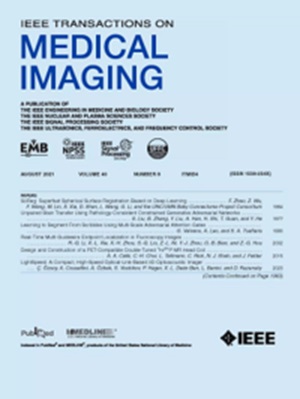低秩域自适应多点功能磁共振成像识别自闭症谱系障碍
IF 8.9
1区 医学
Q1 COMPUTER SCIENCE, INTERDISCIPLINARY APPLICATIONS
IEEE Transactions on Medical Imaging
Pub Date : 2020-03-01
Epub Date: 2019-08-05
DOI:10.1109/TMI.2019.2933160
引用次数: 97
摘要
自闭症谱系障碍(ASD)是一种以广泛的症状为特征的神经发育障碍。识别生物标志物以进行准确诊断对于ASD的早期干预至关重要。多站点数据增加了样本量和统计能力,但也存在着站点间的异质性。为了解决这一问题,我们提出了一个基于低秩表示分解(maLRR)的多位点适应框架,用于基于功能MRI (fMRI)的ASD识别。其主要思想是为来自多个站点的数据确定一个通用的低秩表示,旨在减少数据分布的差异。将一个站点作为目标域,其余站点作为源域,使用低秩表示将来自这些域的数据转换(即改编)到公共空间。为了减少目标域和源域之间的数据异构性,源域的数据在公共空间中由目标域的数据线性表示。我们在合成和真实的多位点fMRI数据上评估了所提出的ASD识别方法。结果表明,我们的方法比几种最先进的域自适应方法具有更好的性能。本文章由计算机程序翻译,如有差异,请以英文原文为准。
Identifying Autism Spectrum Disorder With Multi-Site fMRI via Low-Rank Domain Adaptation.
Autism spectrum disorder (ASD) is a neurodevelopmental disorder that is characterized by a wide range of symptoms. Identifying biomarkers for accurate diagnosis is crucial for early intervention of ASD. While multi-site data increase sample size and statistical power, they suffer from inter-site heterogeneity. To address this issue, we propose a multi-site adaption framework via low-rank representation decomposition (maLRR) for ASD identification based on functional MRI (fMRI). The main idea is to determine a common low-rank representation for data from the multiple sites, aiming to reduce differences in data distributions. Treating one site as a target domain and the remaining sites as source domains, data from these domains are transformed (i.e., adapted) to a common space using low-rank representation. To reduce data heterogeneity between the target and source domains, data from the source domains are linearly represented in the common space by those from the target domain. We evaluated the proposed method on both synthetic and real multi-site fMRI data for ASD identification. The results suggest that our method yields superior performance over several state-of-the-art domain adaptation methods.
求助全文
通过发布文献求助,成功后即可免费获取论文全文。
去求助
来源期刊

IEEE Transactions on Medical Imaging
医学-成像科学与照相技术
CiteScore
21.80
自引率
5.70%
发文量
637
审稿时长
5.6 months
期刊介绍:
The IEEE Transactions on Medical Imaging (T-MI) is a journal that welcomes the submission of manuscripts focusing on various aspects of medical imaging. The journal encourages the exploration of body structure, morphology, and function through different imaging techniques, including ultrasound, X-rays, magnetic resonance, radionuclides, microwaves, and optical methods. It also promotes contributions related to cell and molecular imaging, as well as all forms of microscopy.
T-MI publishes original research papers that cover a wide range of topics, including but not limited to novel acquisition techniques, medical image processing and analysis, visualization and performance, pattern recognition, machine learning, and other related methods. The journal particularly encourages highly technical studies that offer new perspectives. By emphasizing the unification of medicine, biology, and imaging, T-MI seeks to bridge the gap between instrumentation, hardware, software, mathematics, physics, biology, and medicine by introducing new analysis methods.
While the journal welcomes strong application papers that describe novel methods, it directs papers that focus solely on important applications using medically adopted or well-established methods without significant innovation in methodology to other journals. T-MI is indexed in Pubmed® and Medline®, which are products of the United States National Library of Medicine.
 求助内容:
求助内容: 应助结果提醒方式:
应助结果提醒方式:


